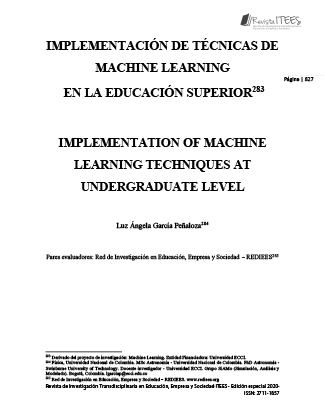XLIII. IMPLEMENTATION OF MACHINE LEARNING TECHNIQUES AT UNDERGRADUATE LEVEL
##plugins.themes.bootstrap3.article.main##
Abstract
The ongoing COVID-19 crisis has led us to think over our teaching methods. The
undergraduate education is not apart from the current transformation, and consequently,
teachers and researchers have realized the need to apply new techniques and methodologies
in our projects. Machine Learning algorithms have become very popular in Astronomy, for
their versatility and high-power of prediction, that results from using these techniques in large
data sets. There are a few current projects that I am developing with undergraduate students:
the first one explores the potential of neural networks to improve the estimate of
cosmological parameters of the ΛCDM standard model. The second work uses the
unsupervised K-means algorithm to classify quasars (very massive, luminous and distant
objects), from their distinctive physical properties observed by SDSS (Sloan Digital Sky
Survey) in data releases 12 and 14. Based on the spectra from these powerful black holes at
high redshift, and other physical properties detected by the Sloan, we classify quasars that
present certain absorption lines.
The main objective of this work is to show the impact of implementing modern Machine
Learning techniques in research projects with Engineering students and the perspectives of
these proposals in other disciplines.
Download Statistics
##plugins.themes.bootstrap3.article.details##
machine learning, deep learning, higher education, neural networks.
https://openai.com/blog/ai-and-compute/. 2019.
M. Ntampaka, C. Avestru, et al. Astro2020 Science White Paper: The Role of Machine
Learning in the Next Decade of Cosmology, arXiv:1902.10159v1
S. Dodelson. Modern Cosmology, Academic Press, Elsevier Science, 2003
S. Ravanbakhs, J. Oliva, et al. Estimating Cosmological Parameters from the Dark Matter
Distribution, arXiv:1711.02033v1
S. Pan, M. Liu, et al. Cosmological Parameter Estimation From Large-scale Structure Deep
Learning, Aceptado en ApJ. arXiv:1908.10590v4
J. H. T. Yip, X. Zhang, et al. From Dark Matter to Galaxies with Convolutional Neural
Networks, Second Workshop on Machine Learning and the Physical Sciences
(NeurIPS 2019), arXiv:1910.07813v1.
Siyu He, Y. Li, et al. “Learning to Predict the Cosmological Structure Formation”, PNAS,
vol. 116, 28, 1–8, 2019.
J. Zamudio-Fernandez, A. Okan, et al. Higan: Cosmic Neutral Hydrogen With Generative
Adversarial Networks, arXiv:1904.12846v1.
E. Giusarma, M. R. Hurtado, et al. “Learning Neutrino Effects Cosmology With
Convolutional Neural Networks”, arXiv:1910.04255v1.
Z. Guo, P. Martini. Classification of Broad Absorption Line Quasars with a Convolutional
Neural Network. The Astrophysical Journal, vol 879, issue 2, 72, 12, 2019.
S. Skillman, M. Warren, M. Turk, et al. Dark Sky Simulations: Early Data Release.
arXiv:1407.2600.
M. S. Warren. 2HOT: An Improved Parallel Hashed Oct-Tree N-Body Algorithm for
Cosmological Simulation. arXiv:1310.4502.
L. A. García, E. Tescari, et al. Theoretical study of an LAE – CIV absorption pair at z = 5.7,
Monthly Notices of the Royal Astronomical Society: Letters, vol. 469, issue 1, pp.
L53-L57, 2017.
L. A. García, E. Tescari, et al. Simulated metal and HI absorption lines at the conclusion of
Reionization, Monthly Notices of the Royal Astronomical Society, vol. 470, issue 2,
pp. 2494-2509, 2017.
L. A. García, E. V. Ryan-Weber. Can UVB variations reconcile simulated quasar absorption
lines at high redshift? Revista Mexicana de Astronomía y Astrofísica, vol. 56, pp. 97-
111, 2020.
P. A. R. Ade et al. Planck 2015 results. XIII. Cosmological parameters, arXiv:1502.01589.
N. Aghanim et al. Planck 2018 results. VI. Cosmological parameters, arXiv:1807.06209.
Y. LeCun, L.D. Jackel, B. Boser, et al. Handwritten Digit Recognition: Applications of
Neural Net Chips and Automatic Learning. IEEE Communication, pp. 41-46, 1989.
D. E. Rumelhart, G. E. Hinton, J. L. McClelland. A general framework for parallel distributed
processing. vol 1: Foundations pp. 45–76, 1986.
L. Deng, D. Yu. Deep Learning: Methods and Applications. NOW Publishers, 2014.
I. Goodfellow, Y. Bengio, A. Courville. Deep Learning. MIT Press,
http://www.deeplearningbook.org, 2016.
D. Osinga. Deep Learning Cookbook: Practical Recipes to Get Started Quickly. O'Reilly
Media, Inc., 2018.
H. Fathivavsari. Deep Learning Prediction of Quasars Broad Ly alpha Emission Line.
arXiv:2006.05124v1
V. de Sainte Agathe, C. Balland, Hélion et al. Baryon acoustic oscillations at z = 2.34 from
the correlations of Ly alpha absorption in eBOSS DR14. Astronomy & Astrophysics,
629, A85, 2019





